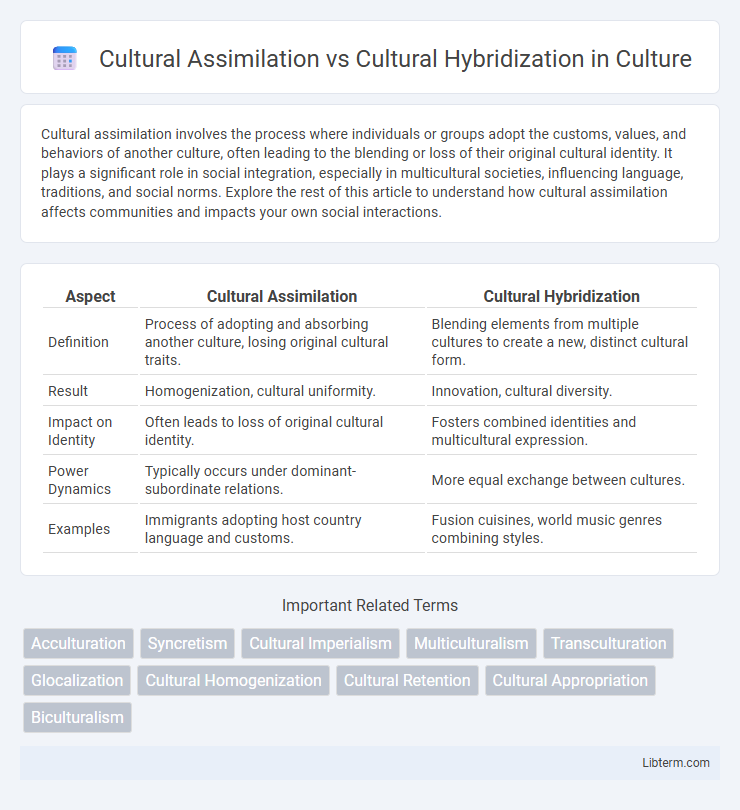Cultural assimilation involves the process where individuals or groups adopt the customs, values, and behaviors of another culture, often leading to the blending or loss of their original cultural identity. It plays a significant role in social integration, especially in multicultural societies, influencing language, traditions, and social norms. Explore the rest of this article to understand how cultural assimilation affects communities and impacts your own social interactions.
Table of Comparison
| Aspect | Cultural Assimilation | Cultural Hybridization |
|---|---|---|
| Definition | Process of adopting and absorbing another culture, losing original cultural traits. | Blending elements from multiple cultures to create a new, distinct cultural form. |
| Result | Homogenization, cultural uniformity. | Innovation, cultural diversity. |
| Impact on Identity | Often leads to loss of original cultural identity. | Fosters combined identities and multicultural expression. |
| Power Dynamics | Typically occurs under dominant-subordinate relations. | More equal exchange between cultures. |
| Examples | Immigrants adopting host country language and customs. | Fusion cuisines, world music genres combining styles. |
Introduction to Cultural Assimilation and Cultural Hybridization
Cultural assimilation involves the process where minority groups gradually adopt the customs, values, and behaviors of a dominant culture, often leading to the loss of original cultural identities. In contrast, cultural hybridization describes the blending of elements from multiple cultures to create new, distinct cultural expressions without erasing original cultural distinctions. Both concepts are essential for understanding how cultures interact and evolve in a globalized world.
Defining Cultural Assimilation: Key Concepts
Cultural assimilation involves the process by which individuals or groups adopt the cultural traits, values, and behaviors of another dominant culture, often leading to the loss of original cultural identities. Key concepts include acculturation, integration, and the dominant-subordinate power dynamic that influences the extent of assimilation. This process contrasts with cultural hybridization, which emphasizes the blending and coexistence of multiple cultural elements to create new, hybrid identities.
Understanding Cultural Hybridization: Core Elements
Cultural hybridization involves the blending of distinct cultural elements, creating new, dynamic cultural forms that reflect global interconnectedness and local creativity. Core elements include the selective adoption, adaptation, and reinterpretation of cultural symbols, practices, and meanings across diverse social contexts. This process challenges traditional dichotomies of assimilation by emphasizing fluid, reciprocal exchanges that foster multicultural identities and innovative cultural expressions.
Historical Contexts: Assimilation and Hybridization Over Time
Cultural assimilation traditionally involved dominant groups absorbing minority cultures, often seen during colonial expansions where indigenous practices were suppressed in favor of the colonizer's traditions. In contrast, cultural hybridization emerged as a dynamic process reflecting globalization, with diverse cultures merging to create new, syncretic identities evident in post-colonial societies and diasporic communities. Historical contexts reveal assimilation frequently aligned with power imbalances and cultural erasure, while hybridization represents ongoing cultural negotiation and adaptation shaping contemporary multicultural realities.
Drivers and Motivators of Cultural Assimilation
Cultural assimilation is primarily driven by factors such as socio-political pressures, economic benefits, and the desire for social acceptance or upward mobility within a dominant group. Motivators include the need to reduce discrimination, access education and employment opportunities, and integrate into mainstream society. This process often involves adopting the language, values, and behaviors of the dominant culture to enhance social cohesion and individual success.
Mechanisms and Processes of Cultural Hybridization
Cultural hybridization involves mechanisms such as syncretism, transculturation, and bricolage, where elements from diverse cultures are selectively integrated to form new, dynamic cultural expressions. Processes include continuous negotiation, adaptation, and reinterpretation of cultural symbols and practices within local contexts, fostering innovation without erasing original identities. This contrasts with cultural assimilation, which often entails the absorption and loss of minority cultural traits to conform to a dominant culture.
Comparative Analysis: Similarities and Differences
Cultural assimilation involves the absorption of one cultural group into another, often leading to the loss of distinct cultural identities, whereas cultural hybridization results in the blending of elements from multiple cultures to create new, syncretic forms without complete erasure of origins. Both processes reflect dynamic cultural change driven by globalization, migration, and intercultural contact, but assimilation emphasizes conformity and dominance, while hybridization emphasizes coexistence and innovation. The key difference lies in assimilation's tendency to produce cultural homogenization versus hybridization's promotion of diversity and creative cultural exchange.
Social Impact and Implications on Identity
Cultural assimilation often leads to the erosion of minority identities as individuals adopt the dominant culture's norms, potentially causing loss of heritage and social marginalization. In contrast, cultural hybridization fosters the blending of diverse traditions, promoting inclusivity and innovation while enabling individuals to maintain multifaceted identities. The social impact of hybridization typically enhances intercultural understanding, whereas assimilation can result in decreased cultural diversity and increased social tensions.
Case Studies: Real-World Examples
The case study of Native American communities during European colonization illustrates cultural assimilation through enforced language loss and adoption of European customs, resulting in significant identity erosion. In contrast, the fusion cuisine emerging in cities like New Orleans exemplifies cultural hybridization, blending African, French, and Caribbean culinary traditions to create unique, shared cultural expressions. These examples reveal how assimilation often involves dominant culture imposition, whereas hybridization fosters mutual cultural exchange and innovation.
Future Trends and Global Perspectives
Cultural assimilation continues to diminish as globalization fosters increased cultural hybridization, blending traditions and innovations across borders. Future trends indicate a shift towards dynamic intercultural exchanges driven by digital communication, migration, and transnational networks. Global perspectives emphasize hybrid identities reshaping social norms and challenging homogeneous cultural models, promoting diversity and inclusivity in global societies.
Cultural Assimilation Infographic

 libterm.com
libterm.com